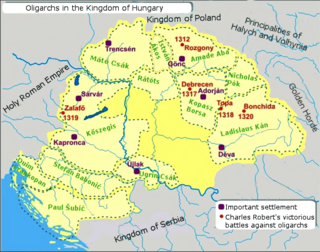The Babonić family (Hungarian: Babonics or Vodicsai) was an old and powerful Croatian noble family from the medieval Slavonia whose most notable members were Bans (viceroys) of Slavonia and Croatia.
| Babonić | |
|---|---|
 | |
| Country | Kingdom of Croatia Kingdom of Hungary Duchy of Carniola |
| Founded | 13th century[1] |
| Founder | Stjepan I (nicknamed Babon)[2] |
| Current head | Extinct |
| Final ruler | Ivan Babonić, Ban of Slavonia, Croatia and Dalmatia[2] |
| Titles | Counts of Gorica and Vodica[2] (Croatian: knezovi Gorički i Vodički), Ban of Primorje, Ban of Slavonia, Ban of Croatia and Dalmatia |
| Dissolution | 14th century[1] |
| Cadet branches | Blagaj family[2] |
History
The first known member of this family who appeared in written documents at the end of the 12th century is Stephen I, known as Babon († at the beginning of the 13th century). The original possessions of Babonić were located on the right bank of the Kupa river between today's Karlovac and Sisak. Their first important stronghold was the town of Steničnjak. They built a stronghold in Blagaj on the Sana in 1240, and the Blagaj Castle in Blagaj on the Korana around 1266.
The rise of the family began at the turn of the 12th and 13th centuries when they received enormous estates from the Kings of Hungary.[3][4][5] At the time of their greatest power, they held huge area from Carniola to Vrbas and from Sava to Gvozd, which also included fortified towns of Medvedgrad, Susedgrad, Kostanjevica and Mehovo.

They were related by blood to the most powerful families of the region, Counts of Gorizia, Venetian Morosini family, Zrinski, Frankopan and the Bosnian Kotromanić royal family through intermarriages.[3]
The family divided their properties in 1313 and 1314 between brothers Ivan (d. after 1334), Stjepan IV (d. 1316) and Radoslav II (fl. 1284–1314). Radoslav received the town and estate of Blagaj on the Sana (Blagay), and his sons stopped using the family name, rather referring to themselves as Counts of Blagay.[2]
Family tree
Below is the complete family tree based on Hungarian historian Pál Engel's Medieval Hungarian Genealogy (2001)[6] and Attila Zsoldos' archontology (2011):
- Godemir
- Stephen I
- Babonega I
- Stephen II (fl. 1243–1256), Ban of Primorje (banus maritimus) (1243–1249)
- Stephen III (fl. 1273–1300), Ban of Slavonia (in or before 1295), Krajna branch
- Ladislaus (fl. 1293)
- Stephen V (fl. 1293)
- Henry (fl. 1345)
- Stephen VI (fl. 1345)
- Radoslav I (fl. 1273–1294), Ban of Slavonia (1288, 1292, 1294)
- Stephen III (fl. 1273–1300), Ban of Slavonia (in or before 1295), Krajna branch
- Babonega II (fl. 1249–1256)
- Nicholas I (fl. 1278–1292)
- Stephen IV (fl. 1278–1316), Ban of Slavonia (1299; 1310–1316), Krupa branch (Krupski)[7]
- George (fl. 1321–1336)
- John II (fl. 1321–1328)
- Denis (fl. 1321–1370)
- Paul (fl. 1321–1381), died without heirs
- John I (fl. 1284–1334), Ban of Slavonia (1317–1322), Ban of Croatia and Dalmatia (1322)
- a daughter (fl. 1328), married Peter II Kőszegi, the ancestor of the Herceg de Szekcső family
- Otto (fl. 1284–1300)
- Radoslav II (fl. 1284–1314)
- Nicholas II (fl. 1321–1330)
- Dujam (fl. 1321–1369), ancestor of the Blagay family
- Stephen II (fl. 1243–1256), Ban of Primorje (banus maritimus) (1243–1249)
References
Sources
Wikiwand in your browser!
Seamless Wikipedia browsing. On steroids.
Every time you click a link to Wikipedia, Wiktionary or Wikiquote in your browser's search results, it will show the modern Wikiwand interface.
Wikiwand extension is a five stars, simple, with minimum permission required to keep your browsing private, safe and transparent.